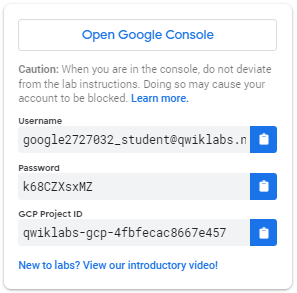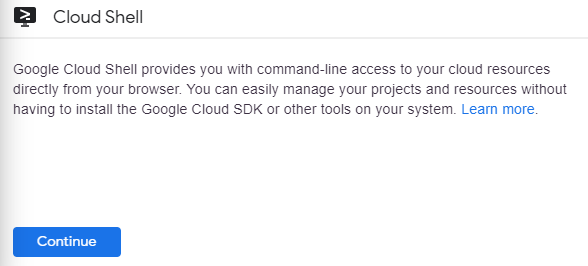Set Up Network and HTTP Load Balancers
GSP007
Overview
In this hands-on lab you'll learn the differences between a network load balancer and an HTTP load balancer and how to set them up for your applications running on Compute Engine virtual machines (VMs).
There are several ways you can load balance on Google Cloud. This lab takes you through the set up of the following load balancers:
You are encouraged to type the commands yourself, which can help you learn the core concepts. Many labs include a code block that contains the required commands. You can easily copy and paste the commands from the code block into the appropriate places during the lab.
What you'll do
Set up a network load balancer.
Set up an HTTP load balancer.
Get hands-on experience learning the differences between network load balancers and HTTP load balancers.
Setup
Before you click the Start Lab button
Read these instructions. Labs are timed and you cannot pause them. The timer, which starts when you click Start Lab, shows how long Google Cloud resources will be made available to you.
This hands-on lab lets you do the lab activities yourself in a real cloud environment, not in a simulation or demo environment. It does so by giving you new, temporary credentials that you use to sign in and access Google Cloud for the duration of the lab.
What you need
To complete this lab, you need:
- Access to a standard internet browser (Chrome browser recommended).
- Time to complete the lab.
Note: If you already have your own personal Google Cloud account or project, do not use it for this lab.
Note: If you are using a Chrome OS device, open an Incognito window to run this lab.
How to start your lab and sign in to the Google Cloud Console
Click the Start Lab button. If you need to pay for the lab, a pop-up opens for you to select your payment method. On the left is a panel populated with the temporary credentials that you must use for this lab.
Copy the username, and then click Open Google Console. The lab spins up resources, and then opens another tab that shows the Sign in page.
Tip: Open the tabs in separate windows, side-by-side.
In the Sign in page, paste the username that you copied from the left panel. Then copy and paste the password.
Important: You must use the credentials from the left panel. Do not use your Google Cloud Training credentials. If you have your own Google Cloud account, do not use it for this lab (avoids incurring charges).
Click through the subsequent pages:
- Accept the terms and conditions.
- Do not add recovery options or two-factor authentication (because this is a temporary account).
- Do not sign up for free trials.
After a few moments, the Cloud Console opens in this tab.
Activate Cloud Shell
Cloud Shell is a virtual machine that is loaded with development tools. It offers a persistent 5GB home directory and runs on the Google Cloud. Cloud Shell provides command-line access to your Google Cloud resources.
In the Cloud Console, in the top right toolbar, click the Activate Cloud Shell button.
Click Continue.
It takes a few moments to provision and connect to the environment. When you are connected, you are already authenticated, and the project is set to your PROJECT_ID. For example:
gcloud is the command-line tool for Google Cloud. It comes pre-installed on Cloud Shell and supports tab-completion.
You can list the active account name with this command:
(Output)
(Example output)
You can list the project ID with this command:
(Output)
(Example output)
Task 1: Set the default region and zone for all resources
In Cloud Shell, set the default zone:
Set the default region:
Learn more about choosing zones and regions here: Regions and Zones documentation
Task 2: Create multiple web server instances
For this load balancing scenario, create three Compute Engine VM instances and install Apache on them, then add a firewall rule that allows HTTP traffic to reach the instances.
Create three new virtual machines in your default zone and give them all the same tag. The code provided sets the zone to
us-central1-a. Setting the tags field lets you reference these instances all at once, such as with a firewall rule. These commands also install Apache on each instance and give each instance a unique home page.
Create a firewall rule to allow external traffic to the VM instances:
Now you need to get the external IP addresses of your instances and verify that they are running.
Run the following to list your instances. You'll see their IP addresses in the
EXTERNAL_IPcolumn:
Verify that each instance is running with
curl, replacing [IP_ADDRESS] with the IP address for each of your VMs:
Check your lab progress
Click Check my progress below to verify that you've created a group of web servers.
Task 3: Configure the load balancing service
When you configure the load balancing service, your virtual machine instances will receive packets that are destined for the static external IP address you configure. Instances made with a Compute Engine image are automatically configured to handle this IP address.
Create a static external IP address for your load balancer:
(Output)
Add a legacy HTTP health check resource:
Add a target pool in the same region as your instances. Run the following to create the target pool and use the health check, which is required for the service to function:
Add the instances to the pool:
Add a forwarding rule:
Check your lab progress
Click Check my progress below to verify that you've created an L4 network load balancer that points to the web servers.
Task 4: Sending traffic to your instances
Now that the load balancing service is configured, you can start sending traffic to the forwarding rule and watch the traffic be dispersed to different instances.
Enter the following command to view the external IP address of the www-rule forwarding rule used by the load balancer:
Use curl command to access the external IP address, replacing IP_ADDRESS with an external IP address from the previous command:
The response from the curl command alternates randomly among the three instances. if your response is initially unsuccessful, wait approximately 30 seconds for the configuration to be fully loaded and for your instances to be marked healthy before trying again.
Use Ctrl + c to stop running the command.
Task 5: Create an HTTP load balancer
HTTP(S) Load Balancing is implemented on Google Front End (GFE). GFEs are distributed globally and operate together using Google's global network and control plane. You can configure URL rules to route some URLs to one set of instances and route other URLs to other instances. Requests are always routed to the instance group that is closest to the user, if that group has enough capacity and is appropriate for the request. If the closest group does not have enough capacity, the request is sent to the closest group that does have capacity.
To set up a load balancer with a Compute Engine backend, your VMs need to be in an instance group. The managed instance group provides VMs running the backend servers of an external HTTP load balancer. For this lab, backends serve their own hostnames.
First, create the load balancer template:
Create a managed instance group based on the template:
Create the
fw-allow-health-checkfirewall rule. This is an ingress rule that allows traffic from the Google Cloud health checking systems (130.211.0.0/22and35.191.0.0/16). This lab uses the target tagallow-health-checkto identify the VMs.
Now that the instances are up and running, set up a global static external IP address that your customers use to reach your load balancer.
Note the IPv4 address that was reserved:
Create a healthcheck for the load balancer:
Create a backend service:
Add your instance group as the backend to the backend service:
Create a URL map to route the incoming requests to the default backend service:
Create a target HTTP proxy to route requests to your URL map:
Create a global forwarding rule to route incoming requests to the proxy:
Check your lab progress
Click Check my progress below to verify that you've created an L7 HTTP(S) load balancer.
Task 6: Testing traffic sent to your instances
In the Cloud Console, from the Navigation menu, go to Network services > Load balancing.
Click on the load balancer that you just created (
web-map-http).In the Backend section, click on the name of the backend and confirm that the VMs are Healthy. If they are not healthy, wait a few moments and try reloading the page.
When the VMs are healthy, test the load balancer using a web browser, going to
http://IP_ADDRESS/, replacingIP_ADDRESSwith the load balancer's IP address.
This may take three to five minutes. If you do not connect, wait a minute, and then reload the browser.
Your browser should render a page with content showing the name of the instance that served the page, along with its zone (for example, Page served from: lb-backend-group-xxxx).






No comments:
Post a Comment